Gym Workout for a Beginner: Your Complete Guide to Starting Strong
A friendly, step-by-step gym workout for a beginner with clear plans, simple progress tracking, and confidence-building tips—no jargon.
Key Takeaways for Your Fitness Journey
- Start with 3 full-body workouts per week, focusing on compound movements like squats, push-ups, and rows
- Begin your workout routine with bodyweight exercises and machines before progressing to free weights
- Allow 48 hours of recovery between training the same muscle groups
- Track your workouts using a simple notebook or app to stay motivated
- Prioritize proper form over heavy weights—master the basics for 2–4 weeks first
Why Every Beginner Needs a Plan
Here’s the truth: about 73% of people who join a gym quit within the first six months. Not because they’re lazy—because it feels like walking into a maze without a map.
I remember my first day at the gym. I had almost no idea how to use the machines, and I was too shy to ask for help, worried someone might judge me for not knowing what to do. If you can picture yourself in that moment, take a breath. This guide is your map. It’ll help you start strong and keep going.
A simple plan works like GPS for your workouts. Research shows beginners who follow a plan often see 10–20% strength gains in 6–8 weeks. Going in without one usually means slow progress and a lot of frustration.
The benefits go beyond muscle:
- Reduced anxiety: Knowing what’s next removes guesswork and nerves
- Faster progress: You’ll see clear, measurable wins
- Fewer injuries: Good form and gradual steps keep you safe
- More confidence: Every completed workout is proof you can do this
Your body is ready for quick wins—you just need the right roadmap.
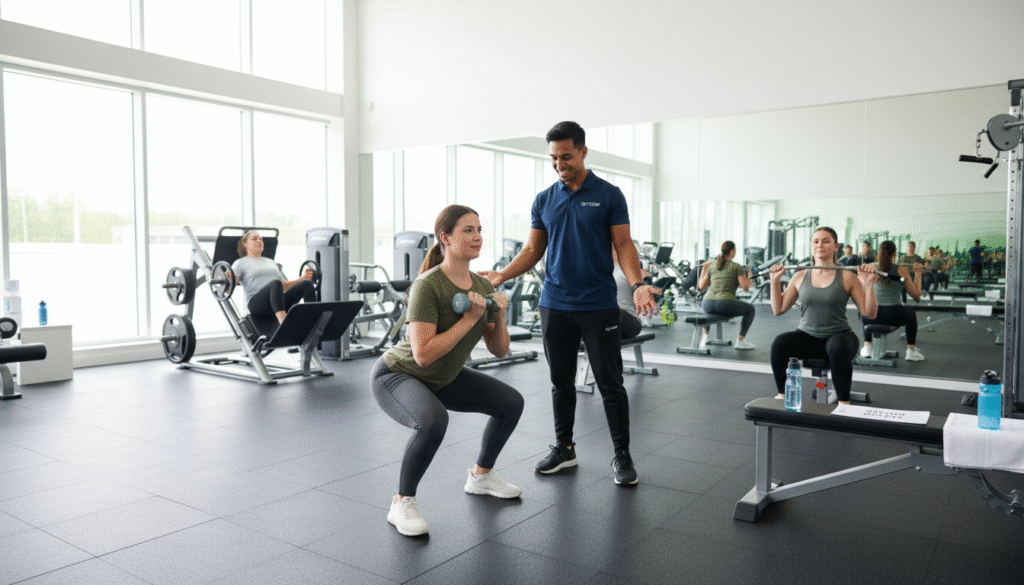
Your First Day Game Plan
Gym anxiety is normal. Thoughts like “I don’t know how to use anything,” “I don’t belong here,” or “Everyone’s watching me” are common—but they’re not true. Most people are focused on their own workout.
Preparation helps a lot for an effective workout:
- Go during off-peak hours (roughly 10am–2pm or after 8pm)
- Ask staff for a quick tour and machine demos
- Bring a friend if it helps you feel at ease
- Wear comfortable clothes that make you feel good
- Bring a written plan so you always know what’s next
Mental prep:
- Remind yourself: “I belong here as much as anyone”
- Focus on your goals, not comparisons
- Set tiny wins for your first visits (learn two machines, then leave proud)
- Tell yourself to feel confident in and out
Your literal first 15 minutes:
- Walk in, find the locker room, put away your stuff (5 min)
- Head to the cardio area and walk on a treadmill for 5 minutes to settle in
- Pick 2–3 machines you’ll use today—ask staff to show you one
- Do your first exercise, even if it’s just one set
- High-five yourself mentally and head out
That’s enough. Your first visit is about comfort, not crushing a workout. Don’t overwork your big muscle groups yet. Get used to the space and find your rhythm. The routine will come.
Beginner Workout Plan: Essential Equipment You Need to Know
At the start, machines are your best friend. They guide your movement, help you feel the right muscles, and lower the chance of injury.
Top 5 beginner-friendly machines you can work on in the first week:
- Leg press: Safely works your lower body – quads, glutes, and hamstrings
- Chest press: Builds upper-body strength without needing a spotter
- Lat pulldown: Trains your back with control
- Shoulder press: Builds overhead strength with stability
- Cable row: Strengthens mid-back and improves posture
When to add free weights: After 4–6 consistent weeks on machines, start adding dumbbells. They train stabilizer muscles and functional strength—but require more coordination, so take your time.
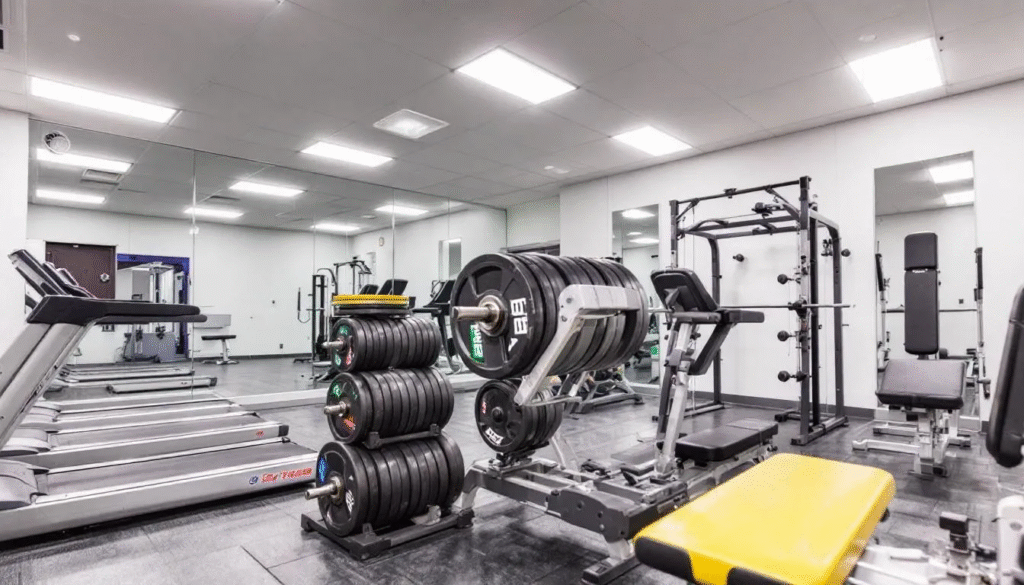
Basic gym etiquette:
- Wipe down equipment after use
- Share machines; let others “work in” between sets
- Re-rack weights where they belong
- Don’t sit on a machine during peak times if you’re resting long between sets
What to bring:
- Supportive shoes and breathable clothing
- Water bottle
- Small towel
- Lock for your locker
The Perfect Beginner Gym Workout Structure
For your first 4–6 weeks, aim for 3 full-body workouts per week. You’ll recover well, build skills, and see steady progress.
Why 3-day full-body works:
- Each muscle group gets trained 3 times per week
- You get 48 hours between sessions to recover
- Easy to stick with—even if you’re busy
- You learn the movements faster
- Improve full body strength
Timing:
- 30–45 minutes per session
- 60–90 seconds rest between sets
- 2–3 minutes between exercises
Weekly schedule options:
- Mon/Wed/Fri
- Tue/Thu/Sat
- Sun/Wed/Fri
Rest days matter—muscles grow when you recover. If you miss a day, just slide the plan forward. Don’t try to double up. Your whole body will thank you later.
Your Warm-Up (Don’t Skip This)

Warm-ups are the “preheat” for your body. Cold starts lead to cold results.
5-minute light cardio:
- Brisk treadmill walk
- Easy cycling
- Gentle elliptical
Dynamic stretches and moves (not long static stretches):
- Arm circles: 10 forward/back each
- Leg swings: 10 front/back and 10 side/side each
- Torso twists: 10 per side
- Hip circles: 5 each direction
A good warm-up reduces injury risk and boosts performance. It’s 5–10 minutes well spent.
Your First Exercise Routine Workout: Machine Day A (Full Body)
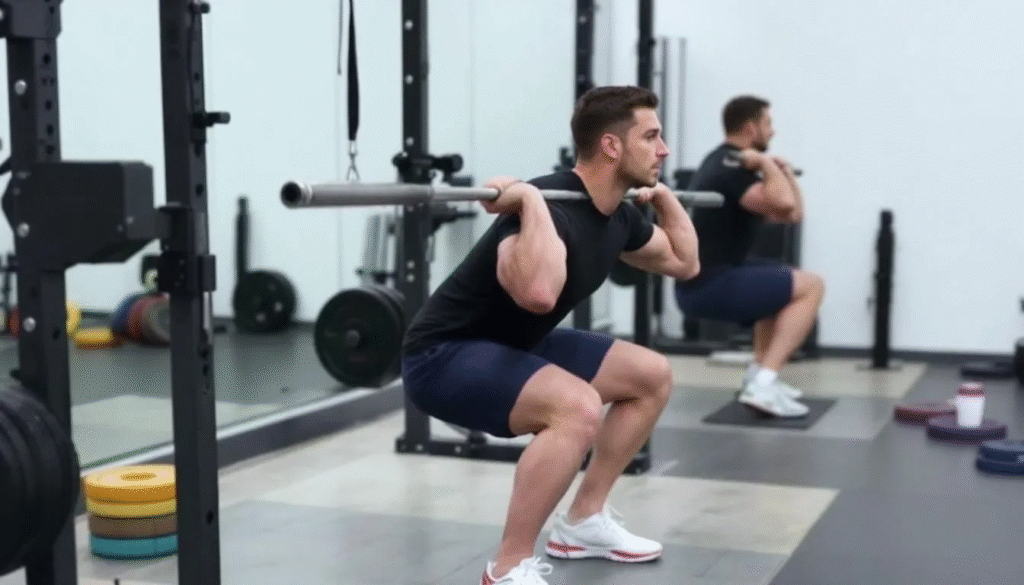
Sets and reps for beginners:
- 2–3 sets per exercise
- 8–12 reps per set
- 60–90 seconds rest
Choosing starting weights: Start lighter than you think. If you can finish with 1–2 reps “in the tank,” you’re right where you should be. Once you hit 12 reps on all sets with great form, increase weight by 5–10% next time.
The Workout
- Leg Press (3 x 10)
- Starting position: Back flat against the pad, feet shoulder-width
- Lower until knees reach about 90°
- Press through heels to return
- Common mistake: Knees caving in—gently push them out
- Can’t do it? Try bodyweight squats first
- Chest Press Machine (3 x 10)
- Handles around mid-chest height
- Press forward without locking elbows
- Control the return
- Common mistake: Shrugging—keep shoulders down and back
- Lat Pulldown (3 x 10)
- Grip slightly wider than shoulders
- Pull bar to upper chest
- Squeeze shoulder blades together
- Control the return up
- Can’t do it? Go lighter—everyone starts somewhere
- Cable Row (3 x 10)
- Sit tall, pull handles to lower ribs
- Lead with elbows, squeeze shoulder blades
- Control the reach forward
- Common mistake: Using momentum—keep it smooth
- Shoulder Press Machine (2 x 10)
- Start at shoulder level
- Press overhead without over-arching your back
- Lower with control
- Plank (3 x 30–45s)
- Straight line from head to heels
- Avoid sagging or piking
- Breathe normally
- Can’t hold 30s? Do 3 x 15–20s
Your Second Workout: Dumbbell Day B (Full Body)
Use this after 2–3 weeks of Machine Day A, or alternate A/B across the week.
- Goblet Squat (3 x 10)
- Hold one dumbbell at your chest
- Feet hip-width, sit back like you’re sitting into a chair
- Chest up, weight through heels
- Can’t do it? Use bodyweight squats first
- Dumbbell Bench Press (3 x 10)
- Lie on a bench, dumbbells at chest level
- Press up, bring them together gently at the top
- Lower with control
- Can’t do it? Try incline push-ups (hands on bench)
- One-Arm Dumbbell Row (3 x 10/side)
- One hand and knee on bench
- Pull dumbbell toward hip, elbow close to body
- Squeeze shoulder blade
- Lower with control
- Dumbbell Romanian Deadlift (3 x 10)
- Hold dumbbells in front of thighs
- Hinge at hips, slight knee bend
- Slide dumbbells down along shins
- Feel hamstrings stretch, then stand tall
- Dumbbell Shoulder Press (2 x 10)
- Dumbbells at shoulder height
- Press overhead
- Lower with control
- Dead Bug (3 x 8–10/side)
- On your back, arms up, knees bent at 90°
- Extend opposite arm and leg
- Keep lower back gently pressed into the floor
- Alternate sides slowly and with control
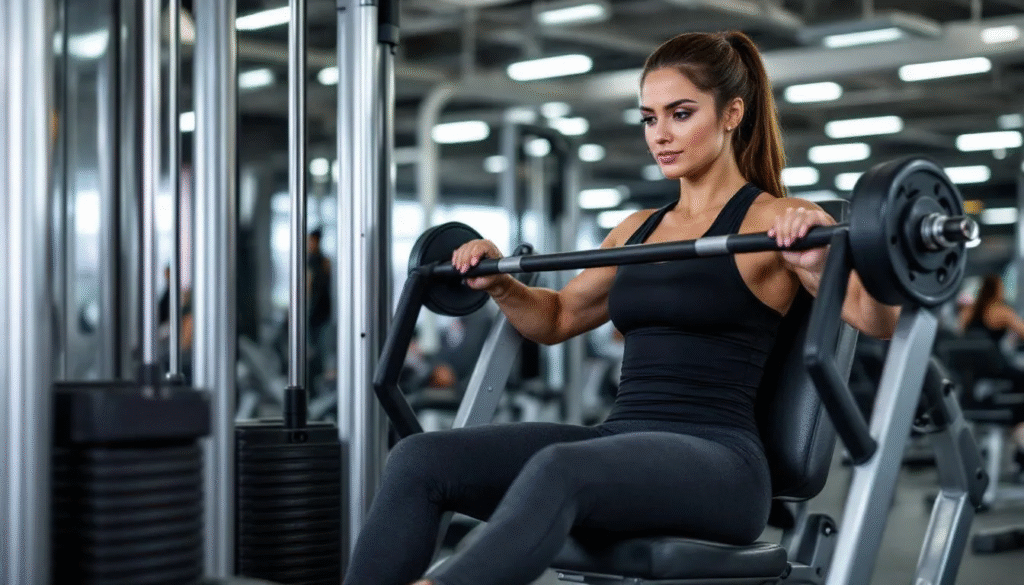
Your 12-Week Roadmap
Weeks 1–2: Foundation
- Learn movement patterns with light weights
- Get comfortable with the gym layout
- Build a consistent schedule
- Confidence > numbers
Weeks 3–4: Progression to Build Muscle
- Increase weights 5–10% when you hit 12 clean reps
- Add one set to key lifts if recovery is solid
- Slightly shorten rest (90s → ~75s) if it feels right
Week 4 (Optional Deload)
- Reduce total sets by ~30–40%, keep weights the same
- Focus on smooth form and mobility
Weeks 5–6: Development
- Mix Machine Day A and Dumbbell Day B
- Keep 3 workouts per week
- Add weight only when form is consistent
Weeks 7–8: Split Option
- Option to move to a 4-day upper/lower split
- Or keep 3x full-body if it’s working well
Weeks 9–12: Commitment
- Stick with your chosen structure
- Week 12: Take another deload week
Cool-Down and Stretching
Cool-down helps your body shift into recovery mode and can reduce next-day stiffness.
- 5-minute easy walk: Gradually bring your heart rate down
- Static stretches (20–30 seconds each):
- Hamstrings: Seated reach
- Quads: Standing heel-to-glute
- Chest: Forearm on wall, gentle lean
- Shoulders: Arm across body
- Back: Overhead reach with side bends
Deep, slow breathing helps your body relax and recover.

Common Beginner Mistakes
- Skipping warm-ups: Five minutes now can prevent weeks off later
- Ego lifting: Form first, weight second—you’ll get stronger faster this way
- Inconsistent schedule: Treat workouts like appointments
- Neglecting recovery: More isn’t better; better is better
- Comparing yourself to others: Aim to beat your last workout, not someone else
- Not tracking: If you don’t log it, it’s hard to improve it
Fitness Routine Progress Tracking Cheat Sheet
What to log:
- Exercise name
- Sets, reps, and weight
- Effort level (1–10)
- Quick notes (e.g., “felt strong,” “tight hips,” “go up next time”)
Golden rule: When you hit 12 reps across all sets with strong form, add ~5% next time.
Green flags you’re progressing:
- Gradual strength increases
- Better control and range of motion
- Steady energy during workouts
- Growing confidence
Recovery, Nutrition, and Lifestyle (Yes, it’s part of your fitness regimen)

Real results happen in the 23 hours you’re not in the gym.
Sleep (superpower #1):
- Aim for 7–9 hours
- Keep your room cool and dark
- Try a consistent bedtime
Nutrition basics:
- Protein: Aim for roughly 0.8–1.0 g per pound of bodyweight daily
- Plate guide: 1/2 veggies, 1/4 protein, 1/4 smart carbs, plus a thumb of healthy fats
- Hydration: Sip water steadily throughout the day
- Post-workout: Prioritize protein within 2 hours
Active recovery:
- Walks, light yoga, easy swimming, mobility work
When to fully rest:
- Persistent soreness, unusual fatigue, nagging pains, high stress, or very poor sleep
Adding Cardio Workouts
Cardio should support your strength training—not slow your recovery.
Beginner-friendly advise: Hesitant to use cardio machines? You can do brisk walking, cycling, swimming, elliptical, rowing
How much cardio workouts should you do?
- 2–3 sessions per week
- 20–30 minutes each
- Moderate effort (you can talk, but not sing)
When to do it:
- After lifting on training days
- On separate days
- Light cardio on rest days
Wait 6–8 weeks before trying high-intensity intervals.
Fitness Goals: Building Long-Term Success
You’re building a habit for life—not sprinting for two weeks.
Think identity over outcome:
- “I’m someone who trains” lasts longer than “I need to lose X pounds”
Make it yours:
- Rotate exercises every 4–6 weeks to stay engaged
- Dial intensity down during stressful weeks
- Keep activities you genuinely enjoy
Set a new focus every 3 months:
- Performance (more reps, more weight)
- Skill (learn new movements)
- Consistency (stick to your schedule)
Treat workouts as self-care. When it feels like something you do for yourself—not to yourself—the habit sticks.
FAQ
How often should a complete beginner work out per week?
- Start with 3 full-body sessions weekly with at least 48 hours between them. After 4–6 weeks, you can move to 4 days if you’re recovering well.
Is it normal to feel extremely sore after my first few workouts?
- Yes. Soreness usually peaks 24–48 hours after training and is a normal sign of adaptation. If soreness is sharp, focused on a joint, or limits normal movement, check in with a doctor.
Should I hire a personal trainer?
- Not required, but 2–3 sessions can help a lot. Trainers teach form, build your first program, and boost confidence. On a budget? Ask staff for quick demos.
What’s the difference between muscle fatigue and pain I should worry about?
- Fatigue: burning during sets, general soreness after that improves with movement.
- Red flags: sharp or worsening pain, swelling, numbness, joint pain, or pain lasting beyond 72 hours.
How long before I see results?
- Strength often improves in 2–3 weeks. Visible muscle tone can show up in 4–6 weeks. Bigger body composition changes usually take 8–12+ weeks. Track progress with photos, measurements, and your training log.
Your Next Step
You don’t need perfect—you need progress. Show up, move well, and keep the promises you make to yourself. Every expert started where you are. You’ve got this.





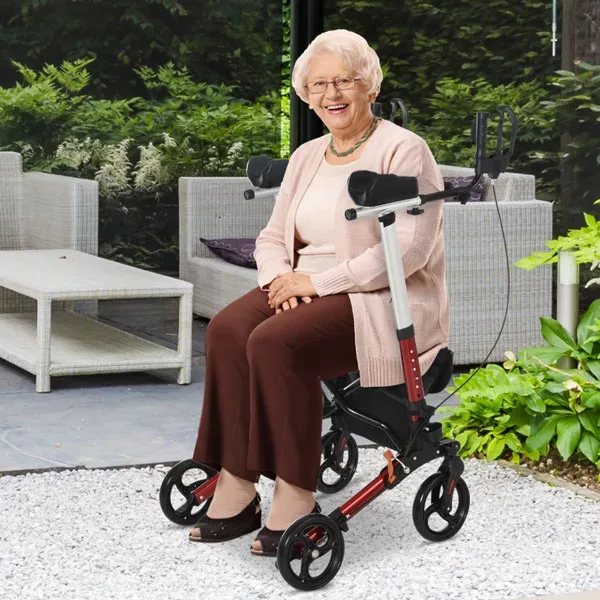
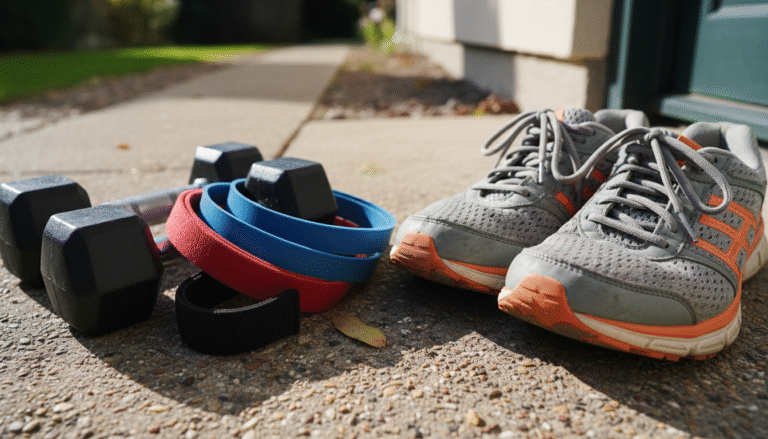

One Comment
Comments are closed.